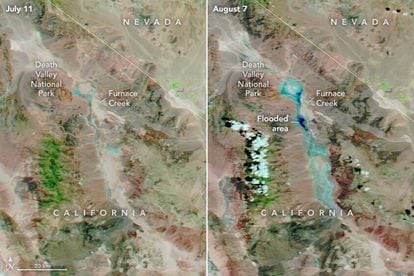In summer in America's Death Valley, tourists like to pose for photos next to a thermometer showing temperatures of more than 122ºF (50ºC) or of themselves frying an egg with a pan on the asphalt.
The desert often comes up in weather reports, but always for breaking record-high temperatures.
Death Valley National Park, located between the states of California and Nevada, is considered the driest place in the United States.
However, in this summer of extreme weather, visitors who dared to brave the heat were surprised by torrential rains – a once-in-1,000-year event.
Access to the park has been closed due to the flooding and the damage caused to the roads by the storm.
This year, the region had been suffering from an intense drought.
About 62 miles (100 kilometers) away, in Lake Mead, outside Las Vegas, the water level has dropped so low that bodies submerged for years or even decades have begun to surface.
One body, found inside a corroded metal barrel, raised questions about mob murders.
Now the area has gone from drought to floods.
“Death Valley is an incredible place of extremes,” said park superintendent Mike Reynolds in a statement released by the National Park Service.
“It is the hottest place in the world, and the driest place in North America.
This week's 1,000 year flood is another example of this extreme environment.
With climate change models predicting more frequent and more intense storms, this is a place where you can see climate change in action!”
“The heavy rain that caused the devastating flooding at Death Valley was an extremely rare, 1,000-year event,” added Daniel Berc, meteorologist with the National Weather Service Las Vegas.
“A 1000-year event doesn't mean it happens once per 1,000 years, rather that there is a 0.1% chance of occurring in any given year.”
About 60 cars were trapped in the mud and debris.- (AFP)
In just three hours, 1.46 inches of rain was recorded, the equivalent of 75% of a year's worth of rainfall.
In a place used to receive rain, the deluge is unlikely to have caused the same level of destruction seen in Death Valley, where there have been landslides and extensive road damage.
As is often the case with floods, the rain has also left the park without drinking water.
Over 600 feet of the water main that supplies the park were blown out by flash floods, leaving some homes, the emergency operations building and other facilities without water.
No injuries among visitors or residents of the park were reported.
Some tourists had their cars trapped in the mud, but were later able to remove them and leave the park, despite the damage to the roads.
High temperatures
Temperatures in Death Valley National Park in summer can reach 120ºF (48ºC) in the shade.
The park holds the highest recorded temperature in the United States.
On July 10, 1913, the thermometer rose to 134ºF (57ºC) at a place called Furnace Creek.
The second-highest temperature ever recorded in the park was 129ºF (54ºC), and was set on August 16, 2020.
The valley is situated 282 feet (86 meters) below sea level.
NASA explains that the desert is subject to the “rain shadow” of the Sierra Nevada mountains.
As an air mass rises to clear the mountains, moisture condenses and falls as rain on the western slopes, leaving a dry area, or rain shadow, on the eastern side.
By the time most air masses reach Death Valley, they are completely dry.
Death Valley has the lowest elevation in all of North America, but it is only about 90 miles (144 kilometers) east of Mount Whitney, which at 14,000 feet, is the highest point in the United States outside of Alaska.
NASA satellite images of the flooding in Death Valley.
On rare occasions, the lower part of the valley is filled with a wide, shallow lake, known as Badwater Basin.
This lake quickly evaporates due to the extreme heat, turning the valley floor into a beach of salt.
Despite its extreme conditions, the Death Valley has been inhabited by the Timbisha tribe of Native Americans for at least the last millennium.
The valley received its name during the California Gold Rush when a group of prospectors tried to cross the valley.
One man died.
The rest were rescued.
As they made their way over the mountains, one member of the group is said to have said: “Goodbye, Death Valley.”

